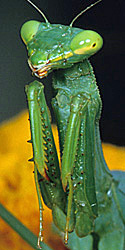|
Mantodea (mantids, praying mantis)
Life > Eukaryotes > Opisthokonta > Metazoa (animals) > Bilateria > Ecdysozoa > Panarthropoda > Tritocerebra > Arthopoda > Mandibulata > Atelocerata > Panhexapoda > Hexapoda
> Insecta
(insects) >
Dictyoptera
 |
There are about 1,800 species of mantids worldwide, falling
in eight families, with a concentration of species in the tropics. Africa
(including Madagascar) boasts the greatest diversity, with about 880 within 156 genera (54 of these genera are
endemic to Madagascar); Asia follows with 530 species in 144 genera, the
Americas with 410 species in 96 genera with a few of these reaching the United
States. Europe only has 24 species contained in 13 genera.
Mantodea is a name derived
from the Greek word meaning prophet or soothsayer. This is probably because of
the mantid's way of sitting with their legs held up in front of their face, as if
in prayer.
Mantids are commonly placed in their own order but in fact genetic,
morphological and biological evidence shows that they evolved from a
cockroach-like ancestor and are more logically placed in a larger taxon,
called the Dictyoptera (sometimes classed as a superorder), which includes the
cockroaches, mantids and
termites.
Learn more about the Mantodea biology
(body structure, life cycle, egg laying, mating etc) |
Families that occur in southern Africa
Acknowledgements
Our thanks to Drs Picker, Griffiths and Weaving for permission to use
their images from their Field Guide to Insects of South Africa.
Publications
-
Picker, M., Griffiths, C. & Weaving, A. 2002.
Field Guide to Insects of South Africa. Struik Publishers,
Cape Town.
-
Scholtz, C. & Holm, E. 1985. Insects of
Southern Africa. Butterworths Professional Publishers (Pty) Ltd, Durban.
-
Preston-Mafham, K. 1992. Grasshoppers & Mantids
of the World. Blandford, U.K.
This mantid site was developed by Dawn Larsen
|
